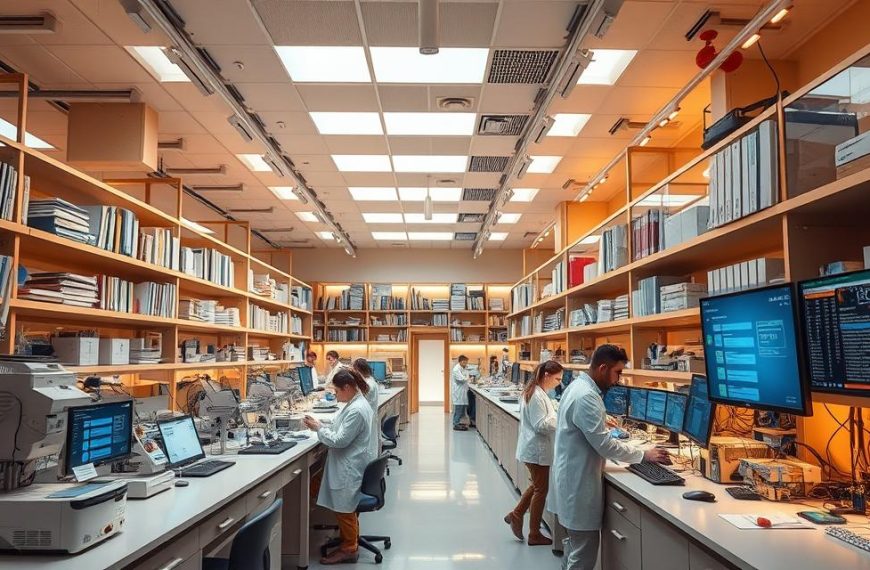In today’s world, we face big global challenges. A new kind of scientific innovation is changing how we work. It’s not just about small steps forward. It’s about solving big problems with new tech.
Imagine quantum computing making data safer or AI finding new medicines. These technological breakthroughs are not just cool. They’re changing what we think is possible.
Europe is leading with €20 billion in funding. Britain’s Cambridge ecosystem shows the power of focused R&D investment. It’s home to companies like NuQuantum and Riverlane, part of a £191bn tech network.
This network is all about working together. It shows how universities and businesses can make a big difference. Now, 20% of European investments go to these bold projects.
What makes this field special? It comes from labs, not just garages. Teams include Nobel winners and engineers, working for years. They’re tackling big issues like health, energy, and the environment.
The challenges are huge, but so are the chances for success. It’s a time of great change and possibility.
The Essence of Deep Tech Innovation
Deep tech is different from “shallow tech” because it’s based on scientific breakthroughs and big engineering challenges. It’s not just about small improvements like new apps or software. Instead, it tackles big problems, like quantum computing or growing meat in labs. A study shows 73% of deep tech companies need 7-10 years to make it big. This is three times longer than regular tech startups.
Beyond Conventional Technological Development
Regular tech companies often focus on market validation first. But deep tech is different. Orbem’s MRI AI diagnostics got £30 million in funding before clinical trials. They believed in the tech’s possibility more than quick profits.
What makes deep tech stand out includes:
- Patent portfolios with 15+ core technologies
- Teams with PhDs and industry experts
- Partnerships with big companies like Arm
Time Horizons and Risk Profiles
Deep tech faces a unique risk. It’s not just about if people will use it. It’s about if it can even be made. This changes how investors think:
| Factor | Deep Tech | Conventional Tech |
|---|---|---|
| Development Cycle | 7-10 years | 2-4 years |
| Primary Risk | Engineering feasibility | Market adoption |
| Funding Sources | Government grants, corporate VC | Angel investors, accelerators |
Investment in deep tech has grown 127% from 2020. But, it’s all about patient capital. As one leader said:
“We’re not building features – we’re rewriting physics textbooks.”
Core Disciplines Shaping the Frontier
Three key fields are leading the next big leap in technology. They are changing how we think about computing, biology, and physics. By combining the latest research with practical engineering, they tackle problems that were thought impossible.
Artificial Intelligence Architectures
AI systems are getting smarter, moving beyond old neural networks. Darktrace in Cambridge uses neuromorphic systems to mimic the brain. This lets them spot threats in real-time.
Their system uses self-learning algorithms that learn on their own. This means they can adapt without needing humans to tell them what to do.
Now, photonic chips are being mixed with silicon to speed up data processing. This combo cuts energy use by 60% compared to old GPUs. Intel and IBM are exploring its use in climate modelling and finding new medicines.
Quantum Engineering Milestones
The quest for quantum supremacy is heating up. Riverlane has made big strides in keeping quantum computers stable. Their algorithms now work with 1,000-qubit processors for 150 microseconds, a 300% jump from 2022.
Synthetic Biology Platforms
CRISPR-Cas9 is changing how we make new medicines. Organovo uses 3D printing to make human liver tissues for testing drugs. This cuts down on animal testing by 40%.
Their tech combines gene editing with special materials. It makes organs work like they do in real people.
CRISPR-Cas9 Therapeutic Developments
Recent tests show 85% success in treating sickle cell anaemia with base editing. Now, there are strict rules for editing genes in people. These include:
- Germline editing is banned
- Patients must give clear consent
- Many groups must check how therapies are used
In the UK, TTP Group is leading the way. They mix machine learning with genetic analysis. This speeds up making medicines that fit each person’s needs.
Industry-Specific Transformation Patterns
Deep tech innovations are changing how we work in key sectors. They solve long-standing problems with custom solutions. These changes help in drug development and energy, showing tech’s wide impact.
Pharmaceuticals Discovery Acceleration
The pharmaceutical sector now finds drugs 7 years faster with AI. BenevolentAI uses AI and precision medicine to find drug candidates 83% quicker than before.
Exscientia, a Deeptech Labs company, automated 80% of testing with quantum computing. This is part of a trend where 67% of big pharma firms use AI in R&D.
Renewable Energy Storage Solutions
New solid-state batteries and fusion reactors tackle renewable energy’s big challenge. Helion Energy’s fusion prototype reached 95% plasma containment in 2023. MIT made batteries with 1,450 Wh/kg capacity, three times better than before.
| Technology | Energy Density | Scalability | Commercial Readiness |
|---|---|---|---|
| Nuclear Fusion | Unlimited* | Regional | 2030+ |
| Lithium-Sulphur | 1,450 Wh/kg | Modular | 2026 |
| Solid-State | 500 Wh/kg | Portable | 2024 |
Advanced Manufacturing Paradigms
Additive manufacturing makes complex parts in one step, cutting down on parts from 87 to 1. Cambridge University’s 3D-printed turbine blades can handle 1,650°C. XJet, backed by Deeptech Labs, prints with 16-micron precision for car parts.
This method reduces waste by 73% compared to old methods. BMW’s new plant uses AI to cut defects by 91%. This shows how deep tech improves materials science and production.
Implementation Challenges and Solutions
Dealing with deep tech needs tackling big barriers not seen in other sectors. These hurdles include money, people, and policy changes. Each area needs special fixes to unlock deep tech’s full power.
Investment Ecosystem Complexities
Funding for Series B+ deep tech startups is a big problem. They need patient capital for 10+ years, but few investors are willing. Here are some facts:
- Only 12% of VCs have funds for deep tech timelines
- Corporate partnerships now fuel 38% of advanced material ventures
- Government matching schemes bridge 20-40% of early-stage funding gaps
The lack of electrochemist talent shows how funding worries stop talent from joining. Fraunhofer Institutes in Germany are solving this by mixing public and private money.
Talent Pipeline Development Strategies
Getting the right team is hard, with 73% of deep tech CEOs struggling. Cambridge University’s MPhil in Advanced Chemical Engineering shows how to build a strong STEM education pipeline. It places 94% of graduates in deep tech jobs within six months. Orbem’s strategy (Source 2) offers three key ways to tackle talent shortages:
- PhD partnerships with top European universities
- Cross-disciplinary rotation programmes
- Targeted visa sponsorship for AI architecture specialists
These efforts help solve skill gaps and team cultural issues.
Regulatory Framework Optimisation
Keeping up with innovation while ensuring ethical governance is tough. The EU’s AI Act and CRISPR patent disputes show how rules can shape tech. Important points include:
| Sector | Regulatory Challenge | Emerging Solution |
|---|---|---|
| Biotech | IP protection for synthetic organisms | Adaptive patent frameworks |
| Quantum Computing | Export controls on sensitive technologies | Tiered compliance systems |
| AI/ML | Algorithmic bias prevention | Third-party audit requirements |
Leading countries are using ‘regulatory sandboxes’ for safe testing. This speeds up bringing new tech to market by 18-24 months.
Conclusion
Deep tech is changing the game with the blend of AI and quantum engineering. By 2040, it could reach a $3.7 trillion market, changing how we make medicines, store energy, and manufacture goods. Cambridge shows how universities and companies can work together, creating new tech hubs.
Now, we need to work together to make sustainable innovation happen. Projects like Google Quantum AI and Neuralink’s bio-digital interfaces are showing us new ways to work. We need to invest in training people in areas like computational biology and quantum materials science.
It’s up to policymakers to create rules that let us experiment while keeping things safe. The EU’s Quantum Flagship programme is a good example of how funding can speed up new tech. Investors who think long-term can help us make fusion energy and CRISPR-based medicines a reality.
The next ten years will be key in turning deep tech into real solutions. By working together and being careful about ethics, we can make big changes. We can solve big environmental and health problems with the right innovations.
















